The Boredom of Married Life
Walter Sickert, David Bowie, telepathy and more!
Coming up this week in The Gallery Companion:
Exciting news if you’re a David Bowie fan. The new, free-to-access V&A East Storehouse in London (which is ace) has just opened up Bowie’s extensive archive to the public.
Also exciting news if you’re a Walter Sickert fan. A new exhibition opening in London on 26 Sept shows rarely seen works by the early 20th-century British artist, including one from the Ennui series on the boredom of married life.
And in another exciting news story about the recent developments in telepathic technology, I give you an extremely short and very potted history of artists who have been inspired by telepathic communication since the late 19th century.
Plus my list of must-see international exhibitions, and art show news from Gallery Companion readers from around the world.
Artists, if you’d like me to give your exhibition a shout-out DM me in the chat function on the Substack app or hit reply to this email. Send me info about it, dates, venue, country, a link to find out more, and a striking image.
Also artists, if your work speaks to any of the ideas in my newsletters, DM me and I’ll include your work in the GC Chat on Substack. That’s exactly what multimedia artist Nastya Kuzmina did when I wrote about art involving drones last week. She created a performance in a circus, training a drone to work with a tiger. I found it funny and thought-provoking.
David Bowie archive at the V&A East Storehouse in London
V&A East Storehouse is a new purpose-built public space for over 250,000 objects, 350,000 library books and 1,000 archives from the V&A’s collections. It opened in May this year, and I think it’s a really exciting project. It’s a new kind of museum experience because it gives visitors a chance to see behind the scenes of a working museum, and to watch curators doing the job of caring for and preserving historical objects.
But the really wonderful thing about this museum is that it gives unprecedented personal access to their collection. Visitors can order an object from the archives which you can get your actual hands on and study up close — just tell them what you want. How fantastic is that? There’s a lot to choose from including fashion, textiles, theatre costumes, jewellery, furniture and much more.
What’s particularly interesting for artists is that there is a huge collection of paintings, and a significant amount of material relating to the history and development of the graphic arts in the UK, spanning from the 19th century to the present day. The material held includes personal papers and correspondence, diaries, sketchbooks and designs, photographs, press cuttings, administrative records and artefacts. Check out the Archive of Art and Design here for more info. For this art history geek it sounds heavenly.
Hardcore fans of David Bowie will be thrilled by the prospect of this research space, given that his archive is now part of the V&A’s collection. I’ve been searching on the V&A’s Order an Object page to find out what’s in his archives. It’s a treasure trove of goodies, with 90,000 objects including costumes, photos, posters, ephemera, merchandise, bootleg albums, scribbled notes and stuff sent to him by fans. Bowie was a collector of stuff, dating back right through his career to his early days.
Less well known about Bowie is that he was a talented visual artist, sketching concepts as part of his creative process, as well as creating artwork for posters and albums.
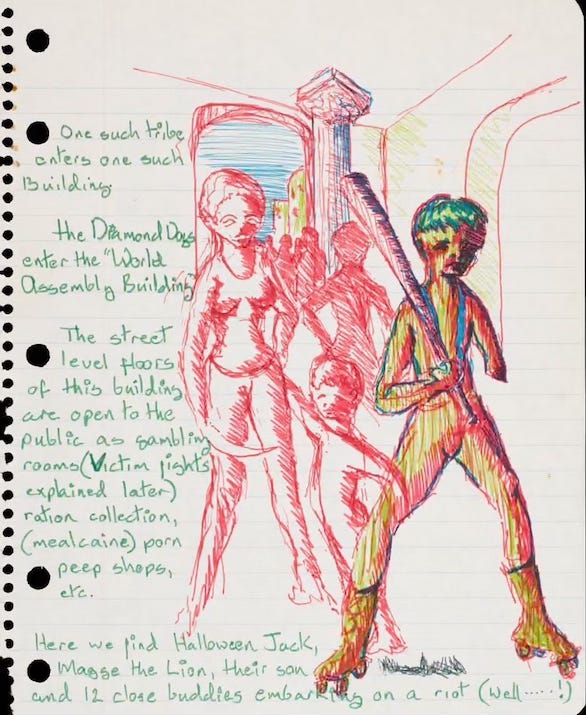
He was also a painter. This self-portrait below dates back to 1988. It’s definitely got some Egon Schiele vibes going on. Bowie was also an art collector, and had a Schiele in his collection (this is a great video from Sothebys on Bowie’s art collection, what he was interested in collecting and why, and how it inspired his creative output).
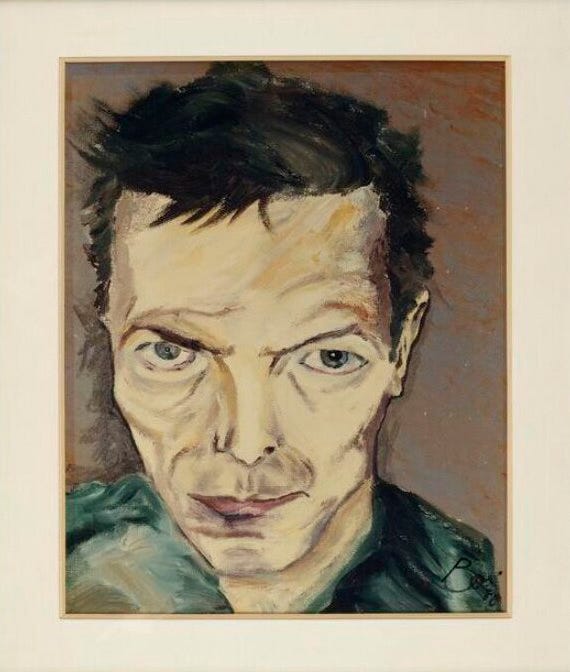
Bowie’s paintings date back to his time living in Berlin with Iggy Pop in the late 70s. He loved German Expressionist art and set up a studio there. He didn’t have any personal ambition as a visual artist but he used paint as a way to find resolutions to obstacles he had whilst making music. Whenever he encountered a creative problem he would draw or paint it out. He said this:
If I found myself in some kind of culture-de-sac in the music I’d break it down, the problem, by actually painting it. I try and visualise what the problem was, that the sense of these textures were grating against each other in a way that wasn’t admirable. I try and visualise those textures and paint them and then find out what was wrong. And then when I’d solved that problem I’d take it back into the studio.
In this 8-minute video Bowie talks about his creative process. I love how he articulates the blurring of boundaries between sounds and visuals, his response to criticism of his work, and his advice to steer away from fulfilling other people’s expectations in creative output:
Rarely seen Walter Sickert drawings, paintings and prints
This one’s for all you Walter Sickert fans out there. From 26 September to 19 December the London gallery Piano Nobile will be showing very rarely seen paintings, drawings and prints by the artist. What a treat! The works are from the personal collection of Herbert and Ann Lucas. The exhibition, titled SICKERT Love, Death and Ennui will feature over 80 works, including life drawings and the prints they relate to, and many of the works are accompanied by Sickert’s dedications, colour notes and annotations.
Walter Sickert (1860–1942) is definitely one of my favourite early 20th-century British artists. He was key to the development of modern British art, and was an inspiration to later British artists such as Lucien Freud, Francis Bacon and Frank Auerbach. He was influenced by the French impressionist artist Edgar Degas, which you can see in Sickert’s loose brushwork, subtle colour harmonies and interest in urban life. There’s something unsettling and psychologically charged about his street scenes, music hall audiences, domestic interiors, and nudes.
Sickert is perhaps best known for his Camden Town period in the decade before WWI when he painted gritty, working-class subject matter, which was strikingly different from the idealised landscapes and society portraits of the Edwardian art scene. In his Camden Town Murder series (1908-9), sparse bedrooms with a nude female and a clothed man ambiguously hint at prostitution, violence and sexual tension.
One of the stand-out works in this show is from Sickert’s series entitled Ennui from 1913-4, which reflects his interest in the psychological nuances of ordinary lives. In a working-class domestic interior a man sits smoking at the table whilst his wife stands behind with her back to him. This particular scene is a close-up of the husband staring into space. The paintings in this series have been interpreted as being about the boredom of marriage, when the drudgery of daily life has taken hold and all joy has died out.
If you’re a fan, and you can, make sure you get to this exhibition at Piano Nobile in London as I think it will be pretty good.
Scientific breakthrough in telepathy
Scientists have made a major breakthrough in telepathic technology, developing the world’s first device that lets people communicate without speaking. Experts at Massachusetts Institute of Technology (MIT) have developed a wearable gadget, worn around the ears, which uses bone conduction to interpret unspoken words into signals. MIT said the new tech could help people with speech disorders to articulate their thoughts, and also enable wordless communication between two users. Wow! This is exciting and almost incredible!
Artists have been fascinated by telepathy since the late nineteenth century when ideas about the unconscious mind, psychology, hysteria and unexplained paranormal experiences started to be scientifically studied and named. The development of new technologies like X-Rays, which enabled people to see through the body, also contributed to the interest in seeing thoughts in the mind. Edvard Munch, Odilon Redon and Auguste Rodin all explored the topic.
The French artist and animator Emile Cohl (1857-1938) made a film in 1910 exploring the inner thoughts of an hysterical man, Le Retapeur de Cervelles (The Creator’s Brain). It’s also interesting to watch as an example of really early artistic film-making:
Throughout the 20th century artists have continued to give material and visual form to the silent communication of thoughts. Abstract, surrealist and conceptual artists have explored the subject of telepathy. Joan Miró, for example, explored the unconscious thoughts of the mind through ‘automatic’ imagery, suppressing conscious control over the making process:
In later years, the development of new Cold War technologies undoubtedly re-energised the interest in the potential of telepathic communications. Conceptual artists since the 1960s explored dematerialising artworks, creating new relationships between artists and audiences, and ideas about telepathy fitted right in to performance-based projects. The Austrian collective Haus-Rucker-Co, for example, encouraged audiences to influence their own environments with their thoughts. Their Mind Expander series (1967-1969) consisted of various helmets that could alter the perception of those wearing them.
More recently artists like Marina Abramovic have also been inspired by the transmission of intangible thoughts between two people. In the series Point of Contact with her collaborator Ulay, they silently explored the presence and energy that resonated between them.
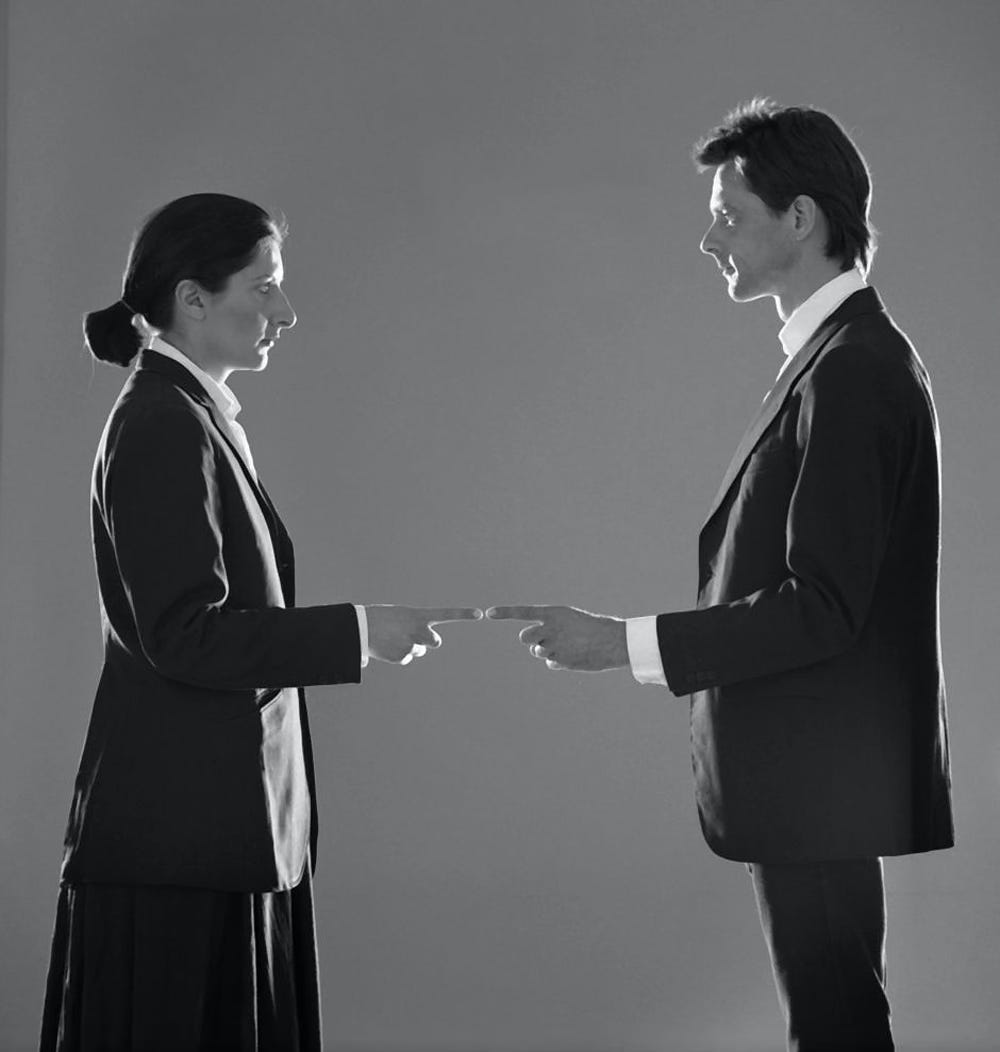
Recent developments in communication technology have inspired other contemporary artists such as Susan Hiller, Nam June Paik, Fabrice Hyber, and Sigmar Polke to explore this subject too. These are just a few examples of artists who have been interested in the subject of telepathy, but there are so many more I haven’t mentioned. It’s a big topic.
I wonder how the realisation of actual telepathic technology will inspire artists interested in this subject today. Please share your thoughts and let me know if your work relates to this subject.
Three exhibitions I’d like to see
Man Ray: When Objects Dream, Metropolitan Museum of Art, New York until 1 Feb 2026. Major exhibition devoted to the artist’s experimentation with rayographs, a new technique he pioneered in 1921 to make photographs without a camera. The show includes many of Man Ray’s most famous images. If you’re a fan of Surrealism and Dada this is one not to miss.
Radical Harmony: Helene Kröller-Müller's Neo-Impressionists, National Gallery, London until 8 February 2026. It’s all about small dots of colour in Paris in the 1880s. Paintings by artists including Seurat, Van Gogh, Signac and Pissarro from the Kröller-Müller Museum’s collection. What’s not to like? Unless of course you’re not interested in the neo-impressionists, which some people find a bit vacuous.
65,000 Years: A Short History of Australian Art, Potter Museum of Art, Melbourne, Australia until 22 November 2025. This exhibition interweaves the resilience of Indigenous art with the history of Australia, from early contact to the present day. One I definitely won’t get to, sadly. Australian readers if you’ve seen it let me know what you thought in the comments!
News from Gallery Companion readers
Get this date in your diary British readers: Melanie Cormack-Hicks’ Elemental exhibition (8-29 Nov) at the Paragon gallery in Cheltenham delves into the connections between light, colour and landscapes. Her work is inspired by the Cotswolds and the rolling hills and stunning coastline of Sussex.
Over in South Australia, Greta Laundy has a big solo show coming up at Art Images Gallery in Norwood. Drawing inspiration from landscapes like the Botanic Gardens, Coorong, and Kangaroo Island, Laundy’s fleeting impressions are transformed into layered abstract paintings, inviting viewers to see the familiar in new and unexpected ways.
In the USA Ann Pham will be participating in Women Artists of the DMV, the first ever survey of established and emerging female visual artists working in Maryland, Virginia, and the Greater Washington DC metro area. Pham, whose art explores our interconnectedness with each other and our planet, will show work at the Strathmore Mansion in North Bethesda from 4 Oct to 8 Nov.
Also in the US Andrea Morganstern currently has a solo show with Museum Mile Contemporary. In her painting and sculpture Morganstern creates abstract biomorphic forms by fusing elements of the human body, animals and plants, using dots as building blocks. It’s wonderful stuff.
That's all for today, GC readers. I’d love to know what you think in the comments about any of the bits n bobs above.
And please help me spread the word about The Gallery Companion. If you know someone who would love this newsletter please share it with them, and restack my post!


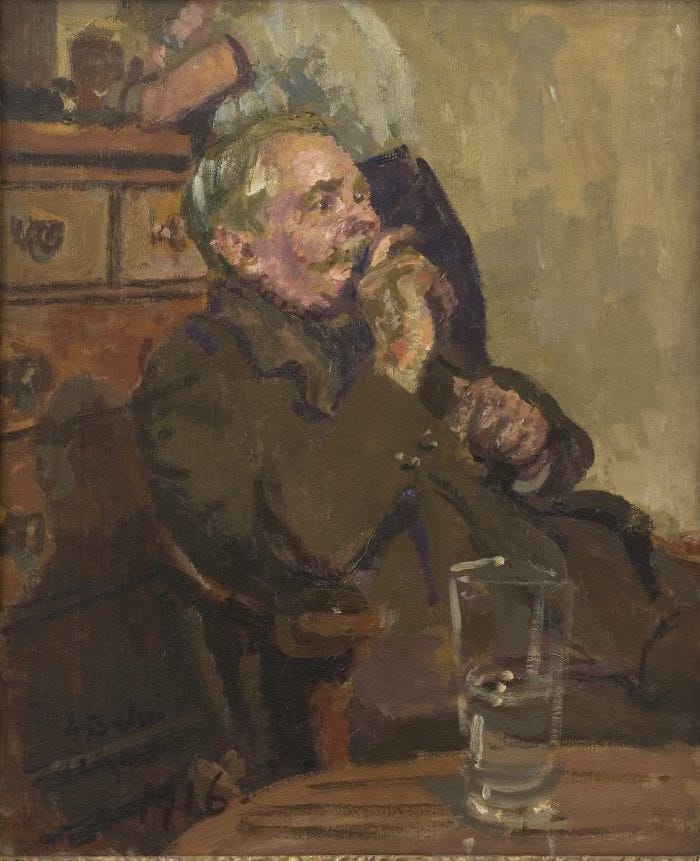
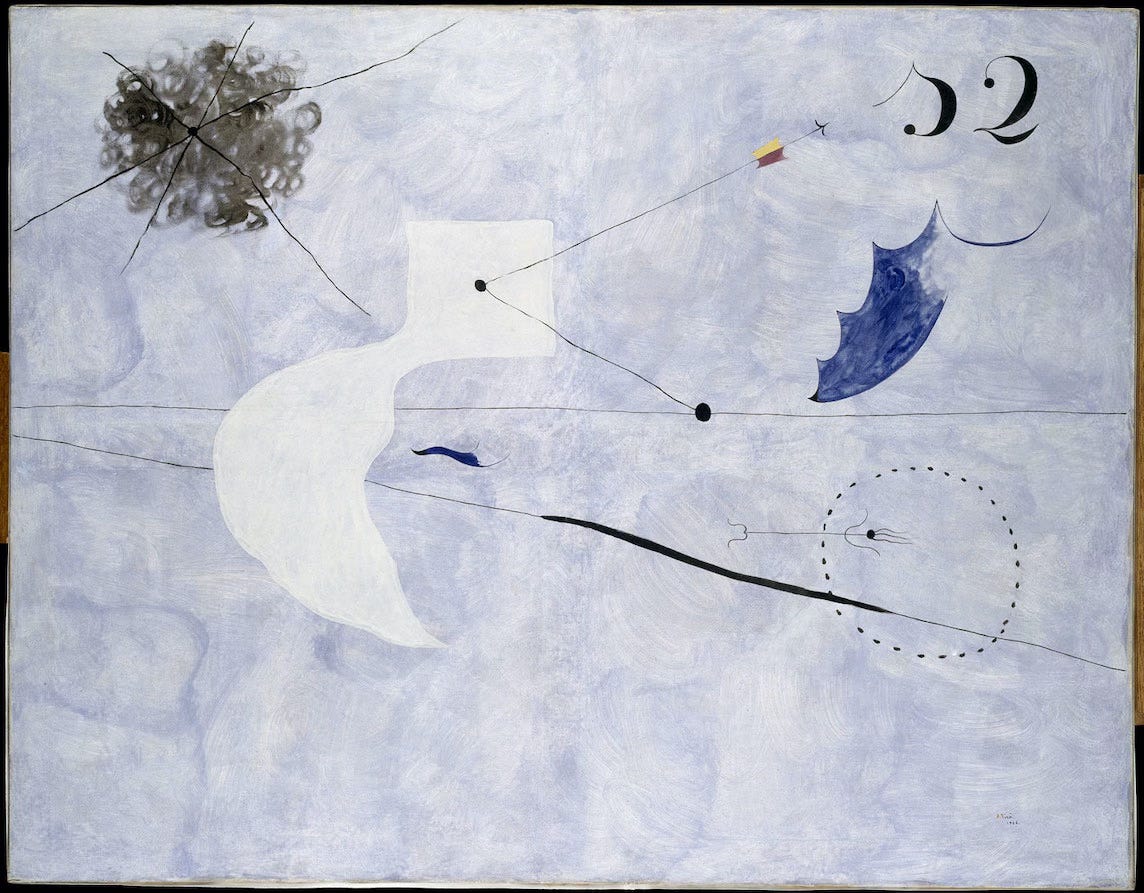

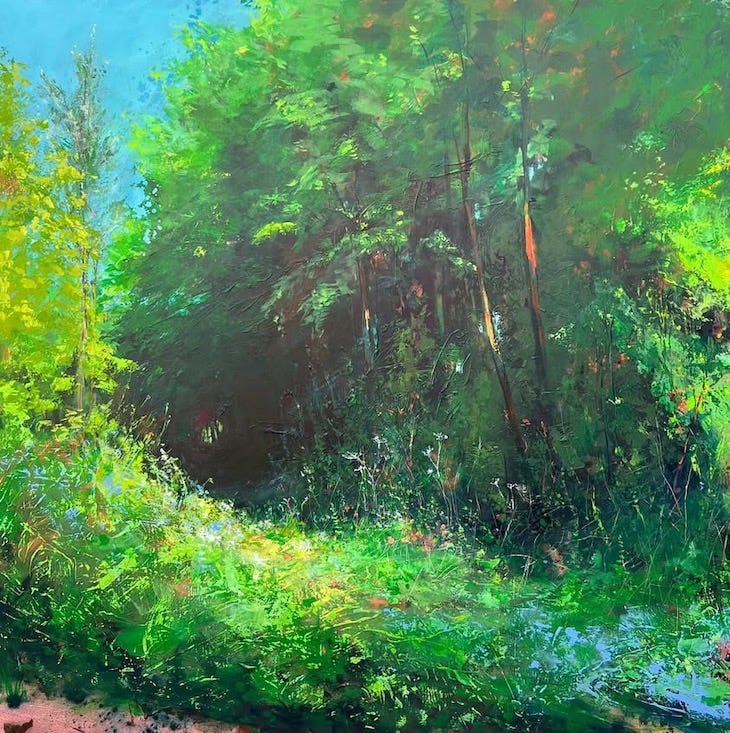
What a treat learning about David Bowie archive and as an artist. I loved his sketch with notes. I write ideas and things I want to include when sketching as well. Thank you for sharing the great news on telepathy. I’ll pay more attention to this topic.
I like the way the morphing line animations in the You Tube clip lend themselves so easily to the idea of ‘a chain of associations’ in psychological activity.
Clever.